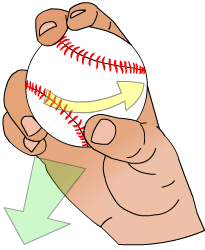Pitch (baseball)


In baseball, a pitch is the act of throwing a baseball toward home plate to start a play. The term comes from the Knickerbocker Rules. Originally, the ball had to be literally "pitched" underhand, as with pitching horseshoes. Overhand throwing was not allowed until 1884.
The biomechanics of pitching have been studied extensively. The phases of throwing include windup, early cocking, late cocking, early acceleration, late acceleration, deceleration, and follow-through.[1]
Pitchers throw a variety of pitches, each of which has a slightly different velocity, trajectory, movement, hand position, wrist position and/or arm angle. These variations are introduced to confuse the batter in various ways, and ultimately aid the defensive team in getting the batter or baserunners out. To obtain variety, and therefore enhance defensive baseball strategy, the pitcher manipulates the grip on the ball at the point of release. Variations in the grip cause the seams to "catch" the air differently, thereby changing the trajectory of the ball, making it harder for the batter to hit.
The selection of which pitch to use can depend on a wide variety of factors including the type of hitter who is being faced; whether there are any base runners; how many outs have been made in the inning; and the current score.
Signaling
The responsibility for selecting the type of pitch was traditionally made by the catcher by relaying hand signals to the pitcher with the fingers, usually one finger for fastball and/or the pitcher's best pitch, with the pitcher having the option to ask for another selection by shaking his head.[2] However, current form is to have the manager or a coach relay the pitch selection to the catcher, via secret hand signals to prevent the opposing team from having the advantage of knowing what the next pitch will be. Starting pitchers typically throw more pitches than relievers.[3][4]
Fastballs
The fastball is the most common pitch in baseball, and most pitchers have some form of a fastball in their arsenal. Most pitchers throw four-seam fastballs. It is basically a pitch thrown very fast, generally as hard as a given pitcher can throw while maintaining control. Some variations involve movement or breaking action, some do not and are simply straight, high-speed pitches. While throwing the fastball it is very important to have proper mechanics, because this increases the chance of getting the ball to its highest velocity, making it difficult for the opposing player to hit the pitch. The cut fastball, split-finger fastball, and forkball are variations on the fastball with extra movement, and are sometimes called sinking-fastballs because of the trajectories. The most common fastball pitches are:
Breaking balls

Well-thrown breaking balls have movement, usually sideways or downward. A ball "moves" due to the changes in the pressure of the air surrounding the ball as a result of the kind of pitch thrown. Therefore, the ball keeps "moving" in the path of least resistance, which constantly changes. For example, the spin from a properly thrown slider (thrown by a right-handed pitcher) results in lower air pressure on the pitcher's left side, resulting in the ball "sliding" to the left (from the pitcher's perspective). The goal is usually to make the ball difficult to hit or confusing to batters. Most breaking balls are considered off-speed pitches. The most common breaking pitches are:
Changeups
The changeup is the staple off-speed pitch, usually thrown to look like a fastball but arriving much slower to the plate. Its reduced speed coupled with its deceptive delivery is meant to confuse the batter's timing. It is meant to be thrown the same as a fastball, but simply farther back in the hand, which makes it release from the hand slower but still retaining the look of a fastball. A changeup is generally thrown 8–15 miles per hour slower than a fastball. If thrown correctly, the changeup will confuse the batter because the human eye cannot discern that the ball is coming significantly slower until it is around 30 feet from the plate. For example, a batter swings at the ball as if it was a 90 mph fastball but it is coming at 75 mph which means he is swinging too early to hit the ball well, making the changeup very effective.[5] The most common changeups are:
Other pitches
Other pitches which are or have been used in baseball are:
Pitching deliveries
The most common pitching delivery is the overhand delivery. Other deliveries include the submarine and the sidearm deliveries.
References
- ↑ Clinical Journal of Sport Medicine. 15(1):37–40, January 2005. Benjamin, Holly J. MD *; Briner, William W. Jr. MD +
- ↑ Andriesen, David (November 2003). Catchers Are Baseball's Least Appreciated Players. Baseball Digest. Retrieved 9 March 2012.
- ↑ "Yankees Pitches". yolasite.com. Retrieved 14 October 2015.
- ↑ "Catcher Signals". Baseball-Catcher.com.
- ↑ Walsh, John (2007-09-19). "Pitch Identification Tutorial". The Hardball Times. Retrieved 2007-09-19.
External links
-
 Media related to Baseball pitch at Wikimedia Commons
Media related to Baseball pitch at Wikimedia Commons
| ||||||||||||||||||||||